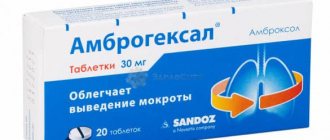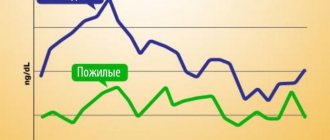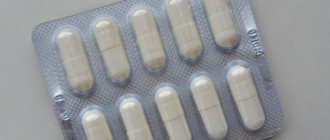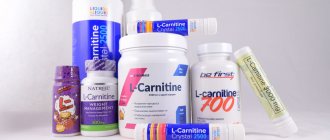Pharmacological properties of the drug Neurorubin
B vitamins are components of enzyme systems that regulate protein, lipid and carbohydrate metabolism. Each of the B vitamins plays a specific biological role. Their presence in the body in a balanced amount is necessary for the normal functioning of metabolism. The drug Neurorubin and Neurorubin-Forte are a combination of 3 vitamins in high doses: B1, B6, B12, which play an important role in the functioning of the nervous system. Each of these vitamins is necessary to ensure optimal metabolism in nerve cells. When high doses of vitamins are consumed simultaneously, they exhibit an analgesic effect. Thiamine mononitrate (vitamin B1) is absorbed in the small intestine, duodenum and jejunum. After ingestion, thiamine penetrates the intestinal mucosa and enters the liver through the portal vein system. After administration, some thiamine is absorbed in the liver. The main metabolites that are released when thiamine is taken (with minor amounts of unchanged thiamine) are thiamine carboxylic acid and pyramine (2,5-dimethyl-4-aminopyrimidine). Pyridoxine hydrochloride (vitamin B6) is rapidly absorbed in the intestine. In the body, pyridoxine is oxidized to pyridoxal and aminated to pyridoxamine. The condition for its functioning as a coenzyme is phosphorylation at the CH2OH group in the 5th position, that is, the formation of pyridoxal-5-phosphate (PALP). In the blood, 80% is associated with proteins. Pyridoxine preferentially accumulates in muscles. The main metabolite that is excreted is 4-pyridoxic acid. Cyanocobalamin (vitamin B12). Normally, the absorption of cyanocobalamin is limited and depends on the concentration of intrinsic Castle factor. Some of the vitamin is absorbed in the free state, but the majority is absorbed after binding to intrinsic Castle factor. After absorption from the gastrointestinal tract, vitamin B12 enters the blood serum. The accumulation of vitamin B12 occurs mainly in the liver. The half-life from serum is approximately 5 days, from liver tissue - approximately 1 year.
Interactions with other medicinal drugs and other types of interactions
High doses of vitamin B6, such as those combined with Neurorubin™, can reverse the therapeutic effect of levodopa in Parkinson's disease, although it may cause seizures if the decarboxylase inhibitor is immediately administered.
The toxicity of isoniazid may increase.
Vitamin B6 may change the effectiveness of altretamine.
One-time use of pyridoxine antagonists (such as isoniazid, hydralazine, penicillamine or cycloserine), oral contraceptives may increase the requirement of vitamin B6.
This thiamine is inactivated by 5-fluorouracil, the remainder of which is competitively inhibited by the phosphorylation of thiamine into thiamine pyrophosphate.
Antacids increase the absorption of vitamin B1.
Loop diuretics, such as furosemide, which interfere with tubular reabsorption, and with continued therapy, can promote thiamine excretion and, thus, reduce its level.
Indications for use of the drug Neurorubin
Oral use: concomitant therapy for diseases of the nervous system, such as:
- neurotic pain in acute and chronic neuritis and polyneuritis;
- neuralgia, as well as toxic damage to the nervous tissue due to alcoholism, drug intoxication, and diabetic polyneuropathy.
Parenteral use: peripheral neuropathy of alcoholic origin, Wernicke-Korsakoff syndrome, diabetic polyneuropathy, beriberi (dry and wet forms); as an adjuvant for acute or chronic neuritis and polyneuritis, trigeminal neuralgia, cervicobrachial neuralgia, sciatica.
Features of good stagnation
The drug cannot be administered internally.
Neurorubin fragments should be administered with vitamin B6, and the drug should be used with caution in patients with a history of peptic varicose veins of the vulva and duodenum, indicating impaired liver and liver function.
Patients with newborns who suffer from seizures that are accompanied by megaloblastic anemia and vitamin B12 deficiency should not take the drug.
The drug should not be used in severe or acute forms of cardiac decompensation and angina.
Continuous monitoring is recommended until signs of peripheral sensory neuropathy appear with repeated use.
Short-term parenteral administration of vitamin B12 can promptly facilitate the diagnosis of funicular myelosis or pernicious anemia.
If there is a sign of peripheral sensory neuropathy (paresthesia), it is necessary to reconsider the dosage of the drug and, if necessary, stop it from stagnating.
Types of neuropathies were prevented with long-term (over 6–12 months) ingested vitamin B6 at doses greater than 50 mg, as well as with short-term (over 2 months) ingestion of vitamin B6 at doses greater 1 g per doba.
Internal ulcerative injections of vitamin B12 may cause anaphylactoid reactions in patients with hypersensitivity.
This medication may require less than 1 mmol (23 mg)/dose sodium, which is practically sodium-free. It is also advisable to administer less than 1 mmol (39 mg)/dose of potassium to ensure a low dose of potassium.
Suspension during pregnancy or breastfeeding.
Vaginism
Clinical studies of the treatment of animals and women with the drug Neurorubin™ during the period of gestation on a daily basis. The potential risk is unknown to people, so it is not recommended to take the drug during pregnancy.
Anniversary breastfeeding
Vitamins B1, B6 and B12 are excreted in breast milk. High concentrations of vitamin B6 may inhibit breast milk production. Data from research on animals up to the stage of secretion of breast milk every day. It is not recommended to stop breastfeeding during breastfeeding. It is necessary to take the drug for breastfeeding or breastfeeding in order to treat breast cancer for the baby and breast therapy for the mother.
This is due to the fluidity of the reaction during treatment with vehicles or other mechanisms.
The drug does not apply to the production of ceruvate by motor transport or by folding mechanisms.
As soon as the drug is administered, one should be careful not to get stuck, so that the treatment can be carried out using transport means and other mechanisms.
Use of the drug Neurorubin
Orally Take orally, before or during meals, without chewing, with a sufficient amount of water. The usual dose for adults is 1–2 tablets per day. The course of treatment is 4 weeks. Treatment can be continued at the discretion of the doctor. Parenteral In case of severe disease, the dose for adults is: at the beginning of use - 3 ml of solution (contents of 1 ampoule) IM daily or every other day until the severity of pain decreases; in the future - 3 ml of solution 1-2 times a week. For moderate disease, the dose for adults is 3 ml of solution 1–2 times a week. Injected intramuscularly into the outer upper quadrant of the gluteal muscle. The duration of treatment depends on the cause of the deficiency of B vitamins; treatment is continued until clinical recovery and/or normalization of laboratory parameters. During long-term therapy, clinical monitoring is carried out every 6 months.
Analogs
There are many identical complexes containing one or more groups of vitamins. These include the following medications:
Milgamma
Manufacturer: Solyufarm (Germany)
Cost: amp. 2 ml No. 5 – 280-300 rub. dragee 100 mg No. 30 – 550-600 rub.
A combined composition that includes a number of essential vitamin elements, which is intended for patients with diagnosed deficiency. The effectiveness of therapeutic properties is based on the interaction of neurotropic elements. Helps eliminate pain, improves microcirculation and activates hematopoietic functions. Prescribed for neuritis, neuralgia, paresis, intoxication.
It goes on sale in two forms: in ampoules for intramuscular administration and in the form of white tablets in a shell. The solution has a characteristic red tint and a specific odor. The dosage is 2 ml twice a day or one tablet three times a day for two weeks to a month.
Advantages:
- Helps relieve pain
- Restores strength.
Flaws:
- Incompatible with sulfate solutions
- Prohibited for children and pregnant women.
Volvit
Manufacturer: Kusum (India)
Cost: tab. No. 30 – 300-350 rub.
The medicine is made on the basis of the active element biotinidase. It takes part in metabolic processes, is responsible for carbohydrate, protein and fat metabolism, normal growth and development of cells. The composition is necessary for gluconeogenesis and regulates insulin levels. Stimulates the functioning of the nervous system and promotes the synthesis of collagen fibers. The product has a positive effect on the condition of the epidermis, improves the structure of hair and nails.
It goes on sale in the form of pink tablets in an oblong shell. The medicine has a sweetish taste. The daily dose is 5-20 mg depending on age. The only contraindication is increased sensitivity to vitamins.
Advantages:
- Can be taken over a long period of time with a short interval
- Helps with hair loss.
Flaws:
- Cannot be combined with pantothene
- May cause side effects.
Side effects of the drug Neurorubin
Hypersensitivity. In patients with hypersensitivity, angioedema may occur. Allergic reactions are observed quite rarely. In isolated cases and under certain conditions, repeated intramuscular injections of preparations containing vitamin B1 can cause anaphylactic shock in patients with hypersensitivity. In these cases, corticosteroids and antihistamines can be used for treatment. Endocrine system. When taking the drug, the release of prolactin is inhibited. Nervous system. In some cases, a feeling of anxiety arose (in patients with hypersensitivity). When taking high doses of pyridoxine hydrochloride (500 mg/day) over a long period of time, isolated cases of reversible peripheral sensory neuropathy have been reported. The cardiovascular system. Isolated cases of tachycardia, circulatory collapse (in patients with hypersensitivity). Respiratory system. Isolated cases of cyanosis, pulmonary edema (in patients with hypersensitivity). Gastrointestinal organs. Nausea, bleeding from the gastrointestinal tract (in patients with hypersensitivity). Liver and gall bladder. High doses of the drug may lead to increased levels of glutamic oxaloacetic transaminase (SGOT) in the blood plasma. Leather. Reactions with itching and urticaria (in patients with hypersensitivity). High doses of the drug may cause acne. Pyridoxine hydrochloride may cause acne. General symptoms. Sudden sweating, feeling of weakness, dizziness.
special instructions
The solution must not be mixed with other medications.
In some cases, the use of excessive doses of pyridoxine hydrochloride (500 mg or more per day) for a long time (more than 5 months) can cause peripheral sensory neuropathy, which is reversible.
The use of cyanocobalamin by patients with psoriasis may worsen the severity of symptoms of the disease.
Due to the possible occurrence in rare cases of undesirable effects (dizziness, weakness) during therapy, it is recommended to exercise caution when driving vehicles and other potentially dangerous mechanisms.
Drug interactions Neurorubin
Because pyridoxine hydrochloride stimulates the decarboxylation of L-dopamine (levodopa) and may reduce the therapeutic effect of this drug in the treatment of patients with Parkinson's disease, the simultaneous use of these drugs should be avoided. The toxicity of isoniazid may increase when used in combination. Thiosemicarbazone and fluorouracil reduce the effectiveness of vitamin B1, being its antagonists. Antacids slow down the absorption of vitamin B1. Vitamin B6 may reduce the effectiveness of altretamine.
Compound
Both forms, both tablet and injection, contain the same amount and different concentrations of the main active ingredients. These are thiamine mononitrate (vitamin B1) 200 mg and 100 mg, respectively, pyridoxamine (B6) in the form of hydrochloride 50 mg and 100 mg and the cyano group of cobalamin (B12) 1 mg.
Cellulose, gelatin, stabilizers and preservatives are used as additional components for the manufacture of tablets. They also contain a lyophilized osmotic diuretic, absorbents, various additives and flavorings.
Method of congestion and dosage
The drug is intended for internal lingual administration.
Dozuvannya
In severe (acute) episodes: 1 ampoule per dose until the intensity of acute symptoms changes.
After relief of symptoms: 1 ampoule 1–3 times per week.
To maintain or extend the initial therapeutic course of injections and to prevent relapse, it is recommended to seal the drug Neurorubin™-Forte Lactab, tablets, sealed with a spit membrane.
Do not exceed the recommended additional dose.
The term cure, which depends on the nature and progression of illness, means doctor.
Zastosuvannya technique.
To open the ampoule:
- trim the ampoule and burn it out at the sight of specks;
- be afraid of the ampoule, do not destroy the bottom part;
- Loosen the head of the ampoule over the markings.







